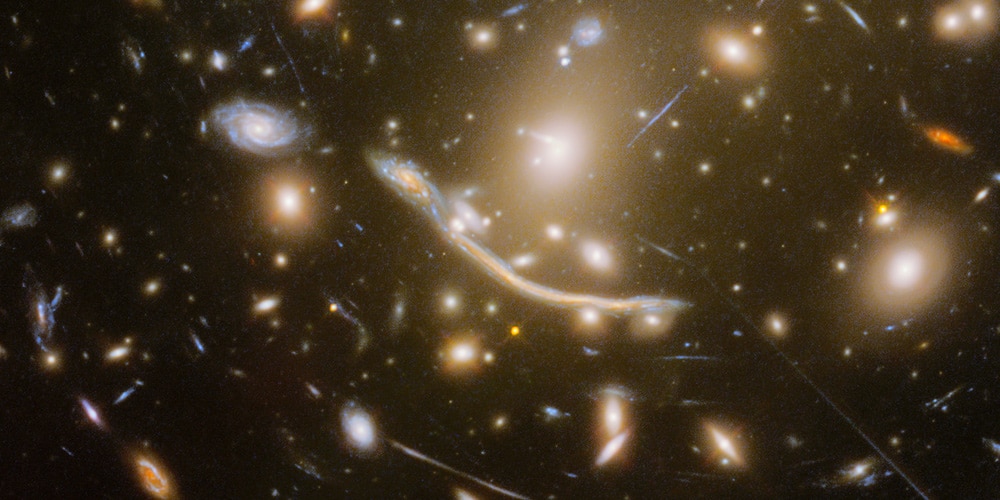Create a free profile to get unlimited access to exclusive videos, sweepstakes, and more!
Space bender: A galaxy cluster distorts the fabric of space, creating beautiful patterns of light

Speaking of galaxy clusters …
It’s pretty rare to find a galaxy that’s all alone in space. For example, our Milky Way is part of a small commune of galaxies called the Local Group, a few dozen galaxies of which we and the Andromeda galaxy are the biggest. The whole grouping is about 10 million light-years across, and most of the galaxies are so small and faint that they were only found relatively recently.
But not everything is like that. There are also clusters of galaxies, the sprawling cities to our Local Group town. The Local Group is on the outskirts of the Virgo Cluster, which has well over a thousand galaxies in it. Because it’s so close -- about 60 million light-years from us, which in cosmic terms puts us in its suburbs -- it’s spread over a lot of the sky, making it look rather sparse from our vantage point.
Abell 370 is another galaxy cluster. It’s probably less populated than Virgo, with only a few hundred galaxies, but at its terribly remote distance of four billion light-years, all those galaxies look like they’re piled up on top of each other. When you aim a telescope like Hubble at such a beast, what you get is sheer wonder:
Whoa. The majority of objects you see in that photo are galaxies! You can see huge, yellow elliptical galaxies, their star formation long since ceased and their aging stellar population turning red; and bluer spiral galaxies, massive young stars giving them that youthful cerulean glow.
But what the heck are all those weirdly distorted arcs and stretched out galaxies? Ah, those are galaxies whose light has been Einsteined. That is, distorted by the gravity of the huge mass of the cluster. This effect, called gravitational lensing, was first proposed by a Russian astronomer named Orest Chwolsen in 1924, but Einstein wrote about it in a more famous paper in 1936 as an outcome of his theory of relativity.
The idea is that mass distorts the shape of space, itself, and we perceive that warp as gravity. As a photon of light moves across space it follows that distortion, like a car follows bends and dips in the road. But this means you can get weird effects. A galaxy emits light in all directions, and some of that light heads toward us on Earth. Some light just misses us, and some is sent in entirely different directions. But if there is a massive object between us and that galaxy, the path of a photon that would normally miss us can get bent toward us due to the distortion of space, and we do in fact see it. That’s why we call this gravitational lensing: The path of light is bent just like it is through a lens.
Here’s a video showing the effect:
The way the light bends depends on lots of things, like how massive the lensing mass is, how far behind it the source of light is, and how far we are from it. It also depends on the shape of the lens; a compact galaxy will bend light differently than, oh, say, a cluster of galaxies. Like Abell 370.
Those arcs you see are actually galaxies behind Abell 370, their shape distorted because their light is following weird paths to us. A very common shape in lensing like this is a simple arc, and you can see a lot of them (back in the day when I worked on Hubble, one of the first targets for our STIS camera once it was installed was a galaxy cluster called RX J1347.521145, and I had a lot of fun processing that image and finding the gravitational lens arcs around it). Every one of those arcs is a galaxy (or maybe even another cluster) located behind Abell 370!
In fact, this is why Hubble was pointed at Abell 370 for this observation. It was done as part of the Frontier Fields project, which looks at a few different galaxy clusters specifically to find the lensed objects. In many cases, the image of the more distant object is magnified and can also appear brighter due to lensing, so clusters provide us with a way of seeing objects near the edge of the observable Universe that would otherwise be too faint to see. In turn, those lensed objects also tell us more about the lens, too. In this case, that’s Abell 370 and the galaxies in it.
And there’s still more! Dark matter is invisible material we know very little about, except it doesn’t emit light on its own. But it has mass, and therefore gravity, so if you have enough of it in one place — like a galaxy cluster — it, too, can warp light coming from the other side, and that light can then be used to map out the location of the dark matter! This has actually been done, many times, and has shown us that dark matter not only exists, but has revealed some of its properties, too.
All this, because light follows bends in space. It’s rather amazing to think of how much we can learn we might otherwise never know about because of simple things like that...if you can call relativistic gravity “simple”. But it’s a rule the Universe follows, so follow it wherever it leads we must as well.



























